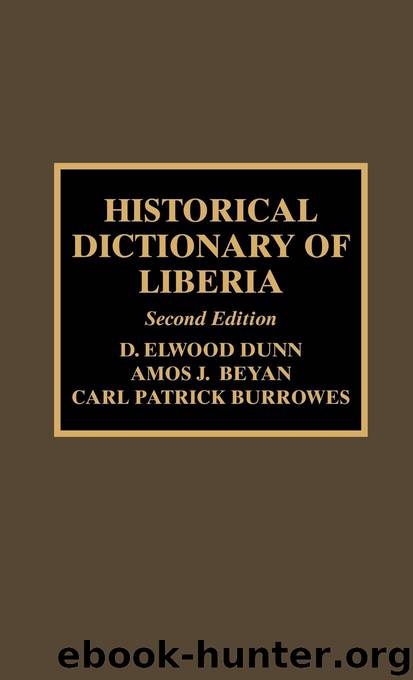Historical Dictionary of Liberia by Dunn Elwood D.; Beyan Amos J.; Burrowes Carl Patrick & Amos J. Beyan & Carl Patrick Burrowes

Author:Dunn, Elwood D.; Beyan, Amos J.; Burrowes, Carl Patrick & Amos J. Beyan & Carl Patrick Burrowes
Language: eng
Format: epub
Publisher: Scarecrow Press
Published: 2001-06-14T16:00:00+00:00
–M–
MA. Known also as the Mano, a name given them by the Bassa, meaning literally, Ma-people, in Bassa. They reside today in Nimba County. They are surrounded by the Republic of Guinea, the Kpelle, Bassa and Dan. A group of Ma also resides in Guinea. The Ma consist of three chiefdoms, namely: Sanniquellie-Mah Chiefdom, which includes the Bein, Gaa, Sei and Yamein clans; Saclepea-Mah Chiefdom, which includes Gbana Gbei, Lao, Lissono, Wei and Zaan clans; and Yarwein-Mehnsonoh Chiefdom, consisting of Mesono, Yaawein and Zenla clans. Their population as of 1984, excluding those living in urban areas, was approximately 149,277 inhabitants.
MAJOR, TAYLOR EMERY (1918- ). Engineer, businessman and politician. Born on November 24, 1918, in Greenville, Sinoe County, he was educated at Liberia College, Howard University (B.A., 1948) and Cornell University (1949-50). His public service includes: enrolling clerk of the Liberian Senate (1942-43); assistant commissioner of communication and chief telephone engineer (1951-53); commissioner of communication and telephone engineer (1953); board chairman of the Public Utilities Authority (1969-72) and senator for Sinoe County (1976-80). He engaged in real estate development during and following his government service.
MALAWU. A Loma town in northwestern Liberia. Malawu is traditionally considered to be a significant Loma town. It is the nerve center of the Poro, a cultural, political, social, religious and educational organization of the Loma, Kpelle, Kissi, Gbande and Mende ethnic groups of pre-Liberia. Most of the supreme leaders of the Poro live in Malawu. One was not allowed to enter Malawu wearing shoes.
MANDING. Commonly known as Mandingo. They are a population which has immigrated into Liberia over the past 200 to 300 years and are today widely scattered over the country. They speak several forms of northern Mande, including Konianka and Maninka. The earliest settlements of Manding are found in western Liberia among the Vai. Today they are represented by two distinctly Manding chiefdoms, namely, in Bomi County, the Mecca Chiefdom, which consists of Upper and Lower Mecca clans; and, in upper Lofa the Kwadu-Boni Chiefdom (also known as Waiglomai-Woniglomai Chiefdom). The former chiefdom is surrounded by the Gola and Kpelle, and is today mainly Kpelle speaking, the latter by the Republic of Guinea and the Loma. The Manding numbered approximately 107,186 individuals in 1984. There were, however, many other Manding living scattered across the whole of Liberia, with particularly large concentrations in the urban areas such as Zwedru, Ganpa, Gbarnga, Kakata and Monrovia.
MANDINGO see MANDING.
MANE. This group is said to have arrived on the pre-Liberian and pre-Sierra Leonean coastal areas just about the time the Europeans arrived in the 15th century. Through military conquests, they succeeded in bringing the Vai and other ethnic groups in pre-Liberia and pre-Sierra Leone under their control. They were also actively engaged in the transatlantic slave trade that took large numbers of Africans from Africa to the Americas between the 15th and the 19th centuries.
MANLY, ARTHUR NANUH (1925-1988). Educator. Born on February 15, 1925, in Rivercess Territory, Grand Bassa County, he was educated at Liberia College (B.A., 1947) and New York University (M.
Download
This site does not store any files on its server. We only index and link to content provided by other sites. Please contact the content providers to delete copyright contents if any and email us, we'll remove relevant links or contents immediately.
A Dictionary of Sociology by Unknown(2869)
The Art of Dramatic Writing: Its Basis in the Creative Interpretation of Human Motives by Egri Lajos(2869)
The Dictionary of Body Language by Joe Navarro(2842)
0041152001443424520 .pdf by Unknown(2638)
How The Mind Works by Steven Pinker(2635)
Day by Elie Wiesel(2616)
Merriam-Webster's Collegiate Thesaurus, Second Edition by Merriam-Webster Inc(2604)
The Meaning of the Library by unknow(2403)
The Official Guide to the TOEFL Test by ETS(2239)
A History of Warfare by John Keegan(2114)
The Emotion Thesaurus: A Writer's Guide to Character Expression by Puglisi Becca & Ackerman Angela(2086)
Emotion Amplifiers by Angela Ackerman & Becca Puglisi(1965)
MASTER LISTS FOR WRITERS: Thesauruses, Plots, Character Traits, Names, and More by Bryn Donovan(1869)
The Cambridge Guide to English Usage by PAM PETERS(1838)
Merriam-Webster's Pocket Dictionary by Merriam-Webster(1821)
Star Wars The Rise of Skywalker The Visual Dictionary by Pablo Hidalgo(1766)
Lucky Jim by Kingsley Amis(1650)
American Accent Training by Ann Cook(1579)
Word by Word by Kory Stamper(1578)
